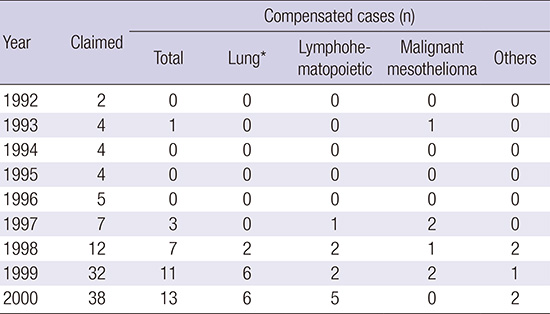1. Kim HR. Overview of asbestos issues in Korea. J Korean Med Sci. 2009; 24:363–367.
2. Kim I, Kim HJ, Lim SY, Kongyoo J. Leukemia and non-Hodgkin lymphoma in semiconductor industry workers in Korea. Int J Occup Environ Health. 2012; 18:147–153.
3. Lee N, Lee BK, Jeong S, Yi GY, Shin J. Work environments and exposure to hazardous substances in Korean tire manufacturing. Saf Health Work. 2012; 3:130–139.
4. Koh DH, Kim TW, Yoon YH, Shin KS, Yoo SW. Lymphohematopoietic cancer mortality and morbidity of workers in a refinery/petrochemical complex in Korea. Saf Health Work. 2011; 2:26–33.
5. Kim EA. The criteria and compensation of occupational cancer. Mon Labor Rev. 2013; 100:26–39.
6. Ahn YS. Occupational cancer update. Korean J Occup Environ Med. 2011; 23:235–252.
7. Kim EA. The topic in the late 1990's, work-relatedness of occupational cancer. Ind Health. 2010; 12. 8–14.
8. Ministry of Employment and Labor. Presidential Decree No.22101. The enforcement decree under Industrial Accident Compensation Insurance (IACI) Act . 2010. 03. 26. Partial Amendment.
9. Ministry of Employment and Labor. Act No.8961. Act on The Prevention of Pneumoconiosis and Protection, Etc., of Pneumoconiosis Workers. 2008. 03. 21. Partial Amendment.
10. Kim EA, Kang SK. Historical review of the list of occupational diseases recommended by the International Labour Organization. Ann Occup Environ Med. 2013; 25:14.
11. International Agency for Research on Cancer (IARC). IARC Monographs on the Evaluation of Carcinogen Risks to Human; 1,3-Butadiene, Ethylene Oxide and Vinyl Halides (Vinyl Fluoride, Vinyl Chloride and Vinyl Bromide). Lyon, France: IARC;2008. Vol 97.
12. International Agency for Research on Cancer (IARC). IARC Monographs on the Evaluation of Carcinogen Risks to Human; Painting, Firefighting, and Shiftwork. Vol 98. Lyon, France: 2010.
13. International Agency for Research on Cancer (IARC). IARC Monographs on the Evaluation of Carcinogen Risks to Human; Some Aromatic Amines, Organic Dyes, and Related Exposures. Lyon, France: IARC;2010. Vol 99.
14. International Agency for Research on Cancer (IARC). IARC Monographs on the Evaluation of Carcinogen Risks to Human; Pharmaceuticals. Lyon, France: IARC;2012. Vol 100A.
15. International Agency for Research on Cancer (IARC). IARC Monographs on the Evaluation of Carcinogen Risks to Human; Biological Agents. Lyon, France: IARC;2012. Vol 100B.
16. International Agency for Research on Cancer (IARC). IARC Monographs on the Evaluation of Carcinogen Risks to Human; Arsenic, Metals, Fibres, and Dusts. Lyon, France: IARC;2012. Vol 100C.
17. International Agency for Research on Cancer (IARC). IARC Monographs on the Evaluation of Carcinogen Risks to Human; Radiation. Lyon, France: IARC;2012. Vol 100D.
18. International Agency for Research on Cancer (IARC). IARC Monographs on the Evaluation of Carcinogen Risks to Human; Chemical Agents and Related Occupations. Lyon, France: IARC;2012. Vol 100F.
19. International Labor Office. List of Occupational Diseases (Revised 2010) Identification and Recognition of Occupational Disease: Criteria for Incorporating Diseases in the ILO List of Occupational Disease. Geneva, Swiss: International Labour Organization;2010.
20. Kim EA. Type, Criteria, and Contents List of the Occupational Diseases of Some ILO member state. Incheon, Korea: Occupational Safety and Health Research Institute, Korean Occupational Safety and Health Agency;2012.
21. Park MI, Choi JS, Choi HM, Jang TI, Moon IH, Kim JH, Jang TW, Lee DH, Jung MH, Kang SK. A case of diffuse malignant pleural mesothelioma with occupational asbestos exposure. Korean J Med. 1995; 48:526–530.
22. Kang SK, Ahn YS, Chung HK. Occupational cancer in Korea in the 1990s. Korean J Occup Environ Med. 2001; 13:351–359.
23. Lee WC, Kim DI, Kwon YJ, Kim HR, Kim IA, Ryoo JH, Kim SG. Workers' compensation claims and approval status for occupational cancers in Korea from 2000 to 2009. Korean J Occup Environ Med. 2011; 23:112–121.
24. Cho SH. Guidelines for work-related diseases. J Korean Med Assoc. 2004; 47:65–74.
25. Lim JW, Park SY, Choi BS. Characteristics of occupational lung cancer from 1999 to 2005. Korean J Occup Environ Med. 2010; 22:230–239.
26. Ahn YS. Occupational malignant lymphohematopoietic diseases compensated under the industrial accident compensation insurance from 1996 to 2005. Korean J Occup Environ Med. 2007; 19:81–92.
27. Ahn YS. Characteristics of occupational lung cancers compensated. In : Proceedings of 43th conference of the Korean Society of Occupational and Environmental Medicine; Jeju, Korea. 2009.
28. Siemiatycki J, Richardson L, Straif K, Latreille B, Lakhani R, Campbell S, Rousseau MC, Boffetta P. Listing occupational carcinogens. Environ Health Perspect. 2004; 112:1447–1459.
29. Cheung YH. Cost of illness and health-friendly fiscal policy. Health Welf Policy Forum. 2009; 156:50–61.






 PDF
PDF ePub
ePub Citation
Citation Print
Print








 XML Download
XML Download